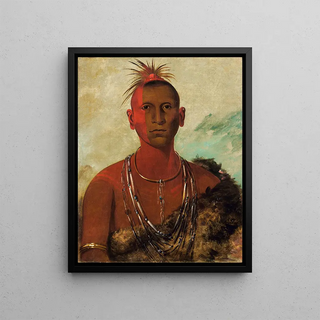Art print | Nh-ses-kuk Whirling Thunder, eldest son of Black Hawk - George Catlin


View from behind

Frame (optional)
The Nh-ses-kuk Whirling Thunder art print, eldest son of Black Hawk - George Catlin – Captivating introduction
In the vast panorama of American art history, certain works stand out for their ability to capture the essence of a culture and an era. The Nh-ses-kuk Whirling Thunder art print, eldest son of Black Hawk - George Catlin, is a perfect example. This painting, created in the 19th century, evokes not only the beauty of Native American traditions but also the complexity of relationships between indigenous peoples and European settlers. Through Catlin's perspective, the viewer is invited to delve into a vibrant world of colors and meanings, where every detail tells a story, and where cultural identity is highlighted with rare sensitivity.
Style and uniqueness of the work
Catlin's work is characterized by a distinctive style, blending realism and romanticism. In the Nh-ses-kuk Whirling Thunder art print, the choice of colors, textures, and the poses of the characters reflect meticulous observation and a deep understanding of the subjects depicted. Catlin does not merely reproduce images; he seeks to convey the soul of the individuals he paints. The figure of Nh-ses-kuk, with its intense expression and dynamic posture, embodies the strength and dignity of Native American peoples. The clothing details, ornaments, and decorative elements, all carefully integrated, contribute to creating an immersive atmosphere, transporting the viewer into a moment suspended in time. This work is not limited to a simple visual representation; it is a true window into a world rich in traditions and stories.
The artist and his influence
George Catlin is an iconic figure of American art, often recognized as one of the first to document Native American cultures through his art. Traveling across the United States, he had the opportunity to meet many chiefs and tribe members, capturing their essence in his portraits. His commitment to preserving these cultures, then threatened by colonial expansion, gives him a unique place in art history. Catlin was not only an artist but also an ethnographer, seeking to educate the public about the richness and diversity of

Matte finish

View from behind

Frame (optional)
The Nh-ses-kuk Whirling Thunder art print, eldest son of Black Hawk - George Catlin – Captivating introduction
In the vast panorama of American art history, certain works stand out for their ability to capture the essence of a culture and an era. The Nh-ses-kuk Whirling Thunder art print, eldest son of Black Hawk - George Catlin, is a perfect example. This painting, created in the 19th century, evokes not only the beauty of Native American traditions but also the complexity of relationships between indigenous peoples and European settlers. Through Catlin's perspective, the viewer is invited to delve into a vibrant world of colors and meanings, where every detail tells a story, and where cultural identity is highlighted with rare sensitivity.
Style and uniqueness of the work
Catlin's work is characterized by a distinctive style, blending realism and romanticism. In the Nh-ses-kuk Whirling Thunder art print, the choice of colors, textures, and the poses of the characters reflect meticulous observation and a deep understanding of the subjects depicted. Catlin does not merely reproduce images; he seeks to convey the soul of the individuals he paints. The figure of Nh-ses-kuk, with its intense expression and dynamic posture, embodies the strength and dignity of Native American peoples. The clothing details, ornaments, and decorative elements, all carefully integrated, contribute to creating an immersive atmosphere, transporting the viewer into a moment suspended in time. This work is not limited to a simple visual representation; it is a true window into a world rich in traditions and stories.
The artist and his influence
George Catlin is an iconic figure of American art, often recognized as one of the first to document Native American cultures through his art. Traveling across the United States, he had the opportunity to meet many chiefs and tribe members, capturing their essence in his portraits. His commitment to preserving these cultures, then threatened by colonial expansion, gives him a unique place in art history. Catlin was not only an artist but also an ethnographer, seeking to educate the public about the richness and diversity of






